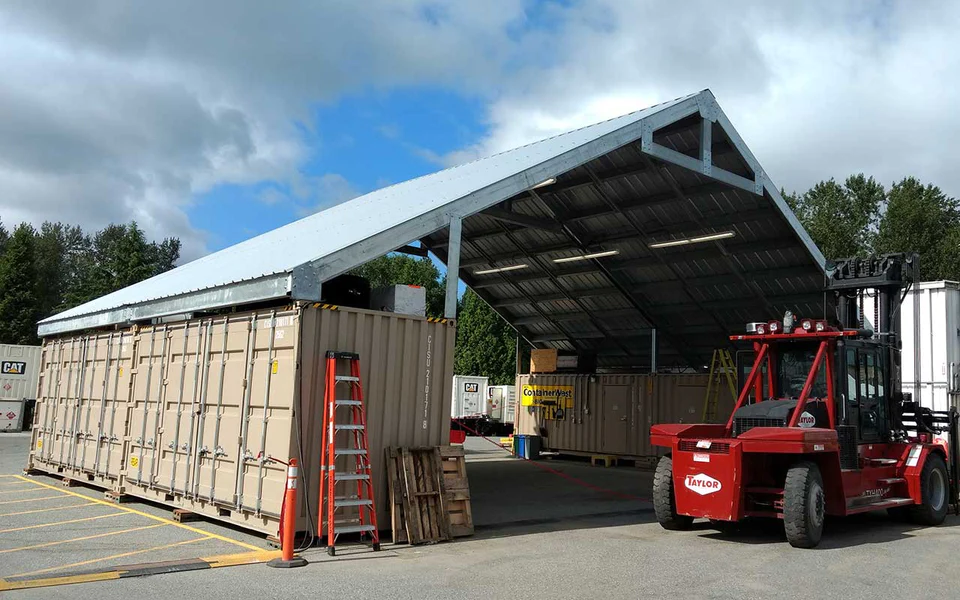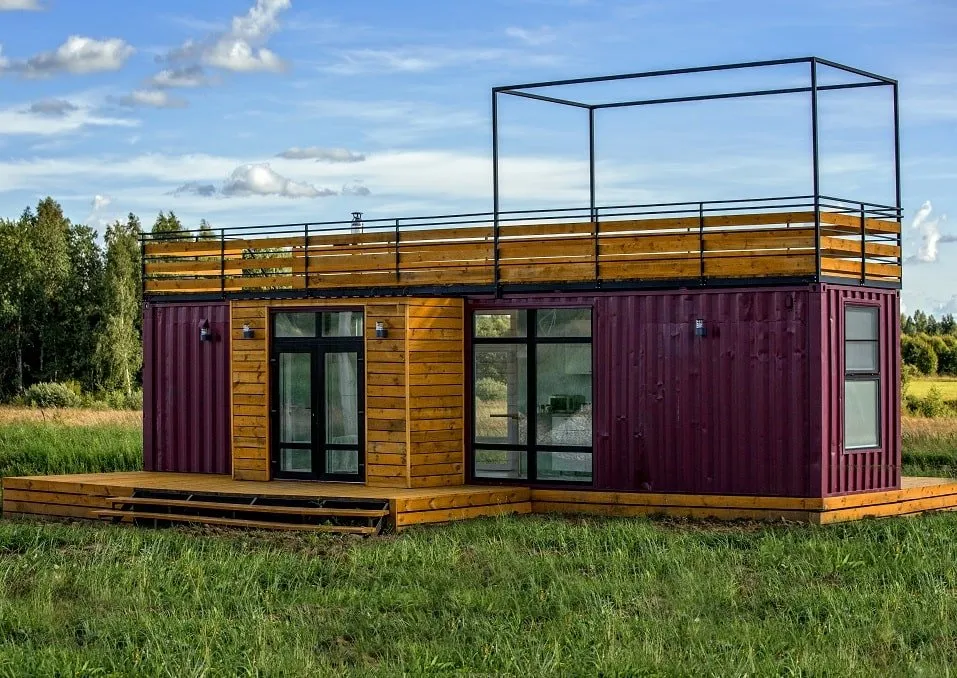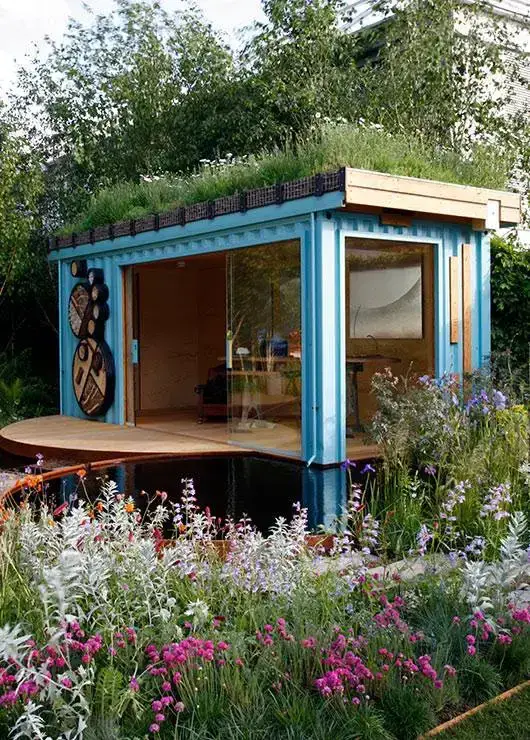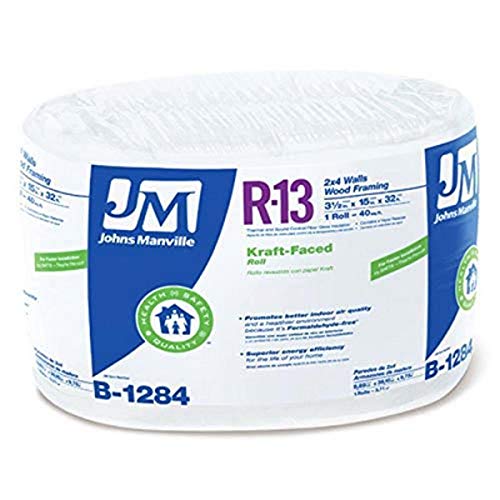A well-designed and functional roof is an essential aspect of shipping container homes. It not only provides protection against the elements but also contributes to the overall aesthetics and durability of the dwelling.
In this article, I will explore the different aspects related to the shipping container home roof, including design considerations, materials used, insulation options, and innovative roofing solutions.
Whether you are planning to build or modify a shipping container home, understanding the importance of a well-designed roof is crucial for creating a comfortable and sustainable living space.
Table of Contents
Understanding Shipping Container Homes
In this section, we will delve into the world of shipping container homes and discover the numerous advantages they offer as a unique housing solution.
A. Brief Explanation of Shipping Container Homes
Shipping container homes, also known as container houses, are residential dwellings constructed using repurposed shipping containers.
These large steel structures, typically measuring 20 or 40 feet in length, are transformed into living spaces that provide a modern and sustainable alternative to traditional housing.
Container homes have gained popularity in recent years due to their affordability, flexibility, and environmentally conscious nature. With creative design and construction techniques, shipping containers can be turned into comfortable and stylish homes.
Read More on Shocking Weight A Container Roof Can Hold
B. Advantages of Building Homes Using Shipping Containers
There are various advantages to choosing shipping containers as the building material for your home’s structure. Here are some key benefits:
- Durability: Shipping containers are designed to endure harsh marine environments, making them highly durable and able to withstand extreme weather conditions.
- Cost-effective: Repurposing shipping containers reduces construction costs as they are readily available and require minimal modifications.
- Speed of construction: With pre-built structures, the construction process is significantly faster compared to traditional homes.
- Flexibility and adaptability: Shipping containers can be easily modified and expanded to suit different needs and preferences.
- Sustainability: Using recycled containers for housing minimizes waste and contributes to sustainable living.
- Portability: If desired, container homes can be transported to different locations, allowing for flexibility and mobility.
These advantages make shipping container homes an attractive option for individuals seeking an affordable, eco-friendly, and versatile housing solution.
Read More on Luxury Container Hotels – Offering Unique Experiences
Types of Container Roofing Styles
1. Shed-Style Roof for Shipping Containers
The advantages of shed-style roofs are that they are inexpensive, quick to build, and easy to install. They also provide good space for generating solar power.
To install a shed-style roof on your shipping container, you will need to weld right-angled steel plates across the length of each side.
Attach wooden beams to the steel plates on either side of the container roof. Then, screw these trusses into place.
Now, you can attach the purlins or steel bars to provide structural support for your roof. To brace the trusses against the wind, place 20-foot-long purlins (wooden beams) on top of them.
You’ll need a structural engineer to provide the specifics you need. This engineer will help you determine how much weight your roof can support.
This figure varies depending on the climate where your home is located, as it takes into account rain, wind, and snow loads.
Coated steel sheets, galvanized metal, and shingles are all viable options for roof coverage. But the coated steel will last longer than the other two materials.
The final step in the construction process is ensuring that your roof has adequate ventilation. Underneath your trusses, attach a fascia and soffit board.
The soffit board should have at least an inch air gap in the middle, covered with wire mesh that allows air to flow out of the attic space by venting registers or holes punched through between rafters.
To allow for ventilation, cut slots in the gable ends of your steel roof. This will help to prevent heat buildup and rust caused by condensation on the underside of a solid sheet metal ceiling.
Read More on Experience Luxury Living In Tasmania With Stunning Container Homes
2. Gable Roof Used in Shipping Containers

Most people imagine a traditional home when they think of gable-styled roofs with distinct triangular shapes.
A gable roof boasts a sloped line that helps it drain rainwater effectively, thus making leaks less likely and extending the life span of your roof.
It is popular for its extra ceiling space, which other roof styles lack. A gable roof is constructed in stages similar to those used for installing a shed-style roof.
To install a gable-style roof on your shipping container, attach right-angled steel plates across the length of the container.
Attach wooden beams to the steel plates on each side of the container. Secure trusses into these beams, and then add purlins to form a substantial roof structure.
Like the shed-style roof, you can use any three options for your metal roofing: shingles, galvanized steel sheets, or coated steel sheets.
You should install a vent at the top of your roof frame. The trusses will hang over the edges of the box, and you can attach fascia boards to cover that space beneath them. It is essential that a soffit board has an air gap in the middle and wire mesh to allow airflow.
Read More on Luxury Container Homes In South Africa: Incredible Concepts
3. Flat Container Roof

A flat-roofed shipping container can be adequate for some purposes. It may be cheaper not to roof your shipping container, but this leaves you vulnerable to water pooling on the roof. If you decide not to roof your containers, it’s essential that a quick safety barrier be installed.
Place a tarpaulin sheet over the roof of your container and cover it with rolls of asphalt. This will keep out water and protect the container’s roof.
Structural Support for the Roof
In a shipping container home, the roof is not only an essential component of the overall structure but also plays a crucial role in ensuring its durability and safety. Proper structural support is paramount to ensure that the roof can withstand various weather conditions and provide a sturdy shelter for the inhabitants.
A. Importance of Proper Structural Support for the Roof in Container Homes
As shipping containers are designed to be stacked vertically, their inherent structure may not be sufficient to support the weight and forces exerted by a traditional roof.
Therefore, additional reinforcement is necessary to ensure the container can withstand the weight of the roof and any potential snow loads, wind pressures, or other external factors.
B. Discussing Different Methods of Reinforcing the Container for Roof Installation
There are several methods to reinforce the container for roof installation. One common approach is to add additional steel beams or trusses to distribute the weight of the roof evenly across the container structure.
These reinforcements enhance the overall structural integrity and prevent any potential deformation or collapse.
Another method involves installing a specialized roof structure that provides the necessary support while minimizing additional weight.
This can include lightweight steel or aluminum frames, timber structures, or even specialized container rooftop systems that are specifically designed for shipping container homes.
When choosing a method for reinforcing the container, it is essential to consider factors such as the local climate, intended roof design, and the expertise of the construction team.
Proper planning and consultation with structural engineers or architects can ensure that the chosen method meets all safety and building code regulations.
- Steel beams or trusses: These provide robust support but may add significant weight to the container.
- Lightweight steel or aluminum frames: These offer a balance between strength and weight.
- Timber structures: Timber can be a sustainable and cost-effective option, but it requires proper maintenance and protection against moisture.
- Specialized container rooftop systems: These pre-designed systems provide a comprehensive solution for container roof reinforcement and often incorporate insulation and weatherproofing features.
Each method has its advantages and considerations, and the choice depends on various factors, including budget, aesthetics, and overall project requirements.
Read More on Are Container Homes Legal in Miami? Find Out the Facts!
Roofing Materials and Options
A. Overview of Popular Roofing Materials Suitable for Shipping Container Homes
When it comes to roofing materials for shipping container homes, there are several options to choose from. Each material has its own unique characteristics and benefits, so it’s important to consider these factors when making a decision. Here are some popular roofing materials suitable for container homes:
- Metal Roofing: Metal roofs are commonly used for shipping container homes due to their durability and longevity. They are resistant to corrosion, fire, and extreme weather conditions. Additionally, metal roofs tend to be lightweight and require minimal maintenance.
- EPDM Roofing: EPDM, or ethylene propylene diene terpolymer, is a type of synthetic rubber roofing membrane. It is lightweight, durable, and resistant to UV rays and extreme temperatures. EPDM roofing is easy to install and can be an affordable option for container homes.
- Green Roofing: Green roofs are a sustainable choice for container homes. They consist of layers of vegetation and growing medium installed on top of a waterproof membrane. Green roofs offer numerous benefits, including improved insulation, reduced energy consumption, and enhanced aesthetic appeal.

- Asphalt Shingles: Asphalt shingles are a popular choice for traditional homes, and they can be used for container homes as well. They are affordable, easy to install, and available in a wide range of colors and styles. However, asphalt shingles may not be as durable as some other roofing materials.
Read More on 10 Surprising Benefits Of A Neat Container Green Roof
B. Exploration of Different Roof Designs and Their Benefits for Container Homes
I already talked about this in passing earlier, but it doesn’t hurt to add a little bit more information on this. So check out these different roof designs and their benefit.
1. Flat Roof Design
A flat roof design is a common choice for shipping container homes. It offers simplicity, cost-effectiveness, and a modern aesthetic.
Flat roofs can be easily installed on container structures and provide additional outdoor space for rooftop gardens, solar panels, or recreational activities.
2. Sloped Roof Design
A sloped roof design, also known as a pitched roof, is another option for container homes. Sloped roofs offer better rainwater drainage and help prevent water pooling on the roof surface. Additionally, sloped roofs provide more interior space and can accommodate attic or loft areas.
C. Pros and Cons of Each Roofing Material and Design for Container Homes
Before making a final decision, it’s essential to weigh the pros and cons of the roofing materials and designs for container homes:
- Metal Roofing: Pros – durability, longevity, resistance to corrosion and fire; Cons – higher upfront cost
- EPDM Roofing: Pros – lightweight, easy installation, affordability; Cons – may require periodic maintenance
- Green Roofing: Pros – sustainability, improved insulation, reduced energy consumption; Cons – higher installation and maintenance costs
- Asphalt Shingles: Pros – affordability, various styles and colors available; Cons – less durability compared to other materials
Insulation and Energy Efficiency
When it comes to creating a comfortable living space in your shipping container home, insulation is key. Proper insulation not only regulates the temperature inside the container, but also plays a vital role in improving energy efficiency.
Let’s explore the importance of insulation in container homes and different insulation options for shipping container home roofs.
A. Importance of Insulation in Container Homes
Insulation is crucial in container homes as it helps regulate the temperature inside the space. Shipping containers are made of metal, which is an excellent conductor of heat.
Without insulation, the container would become unbearably hot in the summer and extremely cold during winter. Insulation provides a barrier against outdoor temperature fluctuations and ensures a comfortable living environment for you and your family.
B. Insulation Options for Shipping Container Home Roofs
1. Spray foam insulation: This type of insulation is a popular choice for container homes as it fills every nook and cranny, creating a seamless barrier against heat transfer. Spray foam insulation is applied as a liquid which expands and solidifies to form a thick layer of insulation. It provides excellent thermal resistance and helps create an airtight seal, reducing energy loss.
2. Rigid foam insulation: Rigid foam panels are another effective option for insulating container home roofs. These panels are lightweight, easy to install, and offer great thermal resistance. Rigid foam insulation is available in different thicknesses, allowing you to choose the right level of insulation for your specific needs.
3. Reflective insulation: Reflective insulation is perfect for hot climates as it helps reflect radiant heat away from the container. It consists of a layer of foil or reflective material that reflects heat back towards its source. Reflective insulation can be installed directly under the roof or wall panels and serves as a great moisture barrier as well.
| Image | Product Title | Features | Price |
|---|---|---|---|
 | Buy on Amazon | ||
 | Buy on Amazon | ||
 | Buy on Amazon |
C. Tips for Improving Energy Efficiency
- Seal any gaps or cracks in the container to prevent air leakage and ensure maximum energy efficiency.
- Consider using double-glazed windows and insulated doors to further enhance insulation and energy efficiency.
- Planting trees or installing shade structures can help reduce the amount of direct sunlight hitting the container, reducing heat transfer.
- Installing solar panels on the roof can not only generate renewable energy but also reduce your reliance on the grid and lower energy costs.
Environmental Impact and Sustainability
Built using repurposed shipping containers, shipping container homes are inherently sustainable and eco-friendly. Here, we explore both the environmentally friendly aspects and the overall sustainability of shipping container home roofs.
Highlighting the Sustainable Aspects of Shipping Container Homes
Shipping container homes are considered sustainable due to their ability to repurpose existing materials. By choosing to recycle and reuse shipping containers, we contribute to reducing waste and minimizing the strain on natural resources.
Additionally, constructing a roof with repurposed containers further emphasizes the ecological advantages of shipping container homes.
Discussing the Environmental Impact of Shipping Container Home Roofs
1. Recycling and Repurposing Containers for Roofing Materials
The use of shipping containers for roofing materials significantly reduces the need for conventional construction materials.
By repurposing containers, we minimize the demand for new resources like wood, metal, and plastic, thereby reducing deforestation and resource depletion.
This sustainable practice also limits the energy required for manufacturing and transportation, further reducing carbon emissions.
2. Energy-Saving Potential with Well-Designed Container Home Roofs
Shipping container home roofs can be optimized for energy efficiency. With proper insulation and a well-ventilated design, container home roofs can help regulate interior temperatures, reducing the need for excessive heating or cooling.
This energy-saving potential contributes to a smaller carbon footprint and a more sustainable living environment.
Considerations for Windows and Doors
Windows and doors play a crucial role in the design and functionality of shipping container homes. Proper placement and installation of these elements are essential for maximizing natural light, ventilation, and access to the outdoors.
Here are some key considerations to keep in mind when it comes to windows and doors in container home roofs:
Importance of Proper Window and Door Placement in Container Home Roofs
One of the primary reasons people choose shipping container homes is because of their ability to seamlessly blend indoor and outdoor living.
Windows and doors play a significant role in achieving this integration. Placing windows strategically in your container home roof can help you take advantage of scenic views and create a sense of spaciousness.
Similarly, doors can provide easy access to outdoor spaces, such as decks or patios. Properly placed windows and doors also allow for effective ventilation, which is crucial for maintaining a comfortable living environment.
Discussing Best Practices for Installing Windows and Doors in Container Homes
When it comes to installing windows and doors in container homes, there are a few best practices to consider. Firstly, it’s important to choose windows and doors that are specifically designed for container structures.
These types of windows and doors are typically reinforced and weather-resistant, ensuring durability and proper performance. Additionally, hiring experienced professionals for installation is highly recommended to ensure proper sealing and insulation.
Another consideration is the size and placement of windows and doors. While larger windows can offer more natural light and panoramic views, they may also affect the structural integrity of the roof.
It’s important to work with an architect or engineer to determine the appropriate size and placement of windows and doors to maintain the overall strength of the container home.
Lastly, the choice of window and door materials should align with the aesthetic vision and functional requirements of your container home.
Options such as aluminum, fiberglass, and vinyl are commonly used due to their durability, low-maintenance nature, and weather resistance.
Cost and Budget Considerations
When building a shipping container home, it’s important to consider the costs and budget implications of the roof. Here, we’ll explore the factors that can affect the overall cost of a container home roof, as well as offer tips for cost-effective roofing options and budget management during the construction process.
A. Overview of Cost Factors Associated with Shipping Container Home Roofs
- Size and complexity of the roof design: The size and complexity of the roof structure can greatly impact the overall cost. Intricate designs or larger roof areas can require more materials and labor, resulting in higher expenses.
- Roofing material choice: The type of roofing material chosen will also influence the cost. While some materials may be more affordable initially, they may require more maintenance or have a shorter lifespan, resulting in higher long-term costs.
- Additional features and accessories: Consideration should be given to any additional features or accessories desired for the roof, such as skylights or solar panels. These can add to the overall cost but may provide long-term cost savings or environmental benefits.
B. Exploring Cost-effective Roofing Options for Container Homes
When working within a budget, there are several cost-effective roofing options available for shipping container homes:
- Metal roofing: Metal roofs are a popular choice for container homes due to their durability and longevity. They can be more expensive upfront but often require minimal maintenance and have a longer lifespan, resulting in potential long-term cost savings.
- EPDM rubber roofing: EPDM (ethylene propylene diene monomer) is a type of rubber roofing that is relatively affordable and easy to install. It provides good protection against the elements and can be a cost-effective choice for container home roofs.
- Spray polyurethane foam: Spray foam insulation can also be used as a roofing material, offering both insulation and waterproofing properties. While it may require additional layers for added durability, it can be a cost-effective option in terms of energy efficiency and maintenance.
C. Tips for budgeting and managing expenses during the construction of a container home roof
Here are some tips to help you manage your expenses and stay within budget when constructing a roof for your shipping container home:
- Create a detailed budget plan: Before starting the construction, create a comprehensive budget plan that includes all the necessary materials, labor costs, and additional expenses. This will help you track and control your spending throughout the project.
- Compare prices and get multiple quotes: Research and compare prices from different suppliers and contractors to ensure you’re getting the best deal. This will help you find cost-effective materials and services without compromising on quality.
- Consider DIY options: Depending on your skill level and the complexity of the project, consider doing some of the work yourself. This can help save on labor costs, but be sure to assess your capabilities and seek professional help when needed.
- Repurpose and recycle materials: Look for opportunities to repurpose or recycle materials during the construction process. This can help reduce costs and environmental impact while adding character to your container home roof.
Creating Warmth and Comfort
When it comes to shipping container homes, creating a warm and cozy atmosphere is essential for a comfortable living experience.
From insulation to design techniques, there are various strategies you can employ to ensure warmth and comfort in your container home roof.
A. Strategies for Ensuring Warmth and Insulation
Insulation is crucial for maintaining a warm temperature inside your container home. By using high-quality insulation materials, you can effectively regulate the interior temperature, keeping it comfortable in all seasons.
One popular option for insulation is spray foam, which provides a seamless and airtight barrier against heat transfer. It can be applied directly to the roof surface, creating a tight seal that prevents air leakage and keeps the interior warm.
Alternatively, you can consider installing fiberglass insulation, which is widely available and relatively cost-effective. It comes in rolls or batts, making it easy to install between the roof beams. Fiberglass insulation offers excellent thermal performance and helps to reduce energy consumption.
B. Techniques to Enhance Comfort
In addition to insulation, there are other techniques you can use to enhance comfort in your shipping container home roof. One such technique is the use of a reflective roof coating.
This coating reflects sunlight, reducing heat absorption and helping to maintain a cooler interior temperature during hot summer months.
Furthermore, incorporating a skylight or roof window not only brings natural light into your container home but also adds a sense of openness and comfort. It allows for better ventilation and can contribute to a healthier indoor environment.
Another way to create warmth and comfort is by considering the roof design. A pitched roof not only provides better drainage but also offers a more spacious and cozy interior. Additionally, you can add a layer of drywall or ceiling cladding to enhance the insulation and give your home a more finished look.
By implementing these strategies and techniques, you can create a shipping container home with a roof that is warm, comfortable, and inviting.
How to Maintain Your Shipping Container Roof
1. Buy Your Container From a Reputable Company
Shipping containers have become increasingly popular for their durability, easy assembly, and versatility.
However, most people don’t realize that the roof of a shipping container does not last forever.
Over time, it will inevitably begin to rust, leading to leaks and structural damage. To ensure that your roof remains in good condition, hire a professional to change it when necessary.
2. Hire a Professional to Change Your Container Roof
It may seem like a straightforward task, but changing the roof of a shipping container requires specialized equipment and knowledge.
This is why hiring a professional who understands what they are doing and has experience with this type of project is important.
If you want to get the good results possible, look for someone with previous experience working with this type of product or whose services have been recommended by others who have had success with them before.
3. Remove Ice and Snow From the Roof
Ice and snow can be very heavy, so make sure to remove them before they cause any damage to your container.
First, use a shovel or broom to get rid of any ice or snow on top of the roof. Then use an ice scraper to remove anything that might still be in place after using the broom or shovel.
If you have leftover snow on your roof, you can use a heat gun or blow dryer to melt it off the surface.
4. Keep Your Container Roof Clear From Dirt and Debris
If dirt or debris is on top of your shipping container, it will cause damage over time as it accumulates.
This can include bird droppings, leaves, and even insects such as spiders. These foreign objects can lead to rusting of the steel sheets, which may cause holes or serious damage to appear over time.
In addition, If dirt gets on top of your roof, it will make it much harder for water to escape during rainstorms or heavy winds.
This can lead to water pooling up in low areas of your roof, which could cause problems like mildew or mold growth inside your home or office space.
5. Conduct Regular Roof Inspections
Your shipping container needs to be inspected on a regular basis to ensure that it’s in good condition. The inspection frequency will depend on your container’s use and the environment in which it is placed.
If your receptacle is located outside or in an area with high levels of precipitation, such as near a body of water, then you should inspect it more often than in a dry area. In addition,
if your container has been sitting outdoors for some time, you should conduct more frequent inspections.
6. Treat Surface Rust on the Roof
If you notice surface rust on your shipping container, there are several steps you can take to remove it.
You can use a wire brush or sandpaper to remove the rust before painting over it with primer and then top coat paint.
Alternatively, suppose you don’t want to repaint the entire unit. In that case, you can use a rust converter spray to convert the rust into a protective coating that will inhibit further corrosion on your unit’s surface.
Conclusion
Recap of the Importance of a Well-designed Shipping Container Home Roof
Throughout this guide, we have explored the various aspects of designing and constructing a shipping container home roof.
From understanding the structural support needed to choosing the right roofing materials, we have covered it all. The roof of a shipping container home plays a crucial role in ensuring the overall strength and durability of the structure.
Not only does the roof provide protection against the elements, but it also helps to maintain a comfortable and energy-efficient living environment inside the home.
Proper insulation and ventilation contribute to the overall energy efficiency, keeping the temperature regulated and reducing the reliance on artificial heating and cooling.
Additionally, the roof of a shipping container home has a significant impact on its environmental sustainability.
By selecting sustainable and eco-friendly materials for the roof and incorporating renewable energy sources, such as solar panels, shipping container homes can minimize their carbon footprint and contribute to a greener future.
Final thoughts on the Potential of Shipping Container Homes to Revolutionize the Housing Industry
Shipping container homes have gained immense popularity over the past few years, and for good reason. These innovative dwellings have the potential to revolutionize the housing industry by offering an affordable, sustainable, and flexible living solution.
The adaptability of shipping containers allows for endless design possibilities, catering to various needs and preferences.
Whether it’s a small, cozy home for a single individual or a larger, multi-container structure for a family, shipping container homes can be customized to fulfill the unique requirements of each homeowner.
Furthermore, the cost-effectiveness of shipping container homes makes them an attractive option for individuals looking to build their own home without breaking the bank.
With proper planning and consideration, shipping container homes can provide a high-quality living space at a fraction of the cost of traditional construction.
As we move towards a more sustainable future, shipping container homes have a vital role to play. By repurposing used containers and incorporating environmentally friendly practices, such as energy-efficient roofing and off-grid capabilities, these homes have the potential to reduce our impact on the environment while still providing comfortable and stylish living spaces.
In conclusion, the roof of a shipping container home is a crucial element that should not be overlooked. It offers protection, energy efficiency, and sustainability, making it an essential component of any well-designed shipping container home.
With the potential to revolutionize the housing industry, shipping container homes present an exciting and forward-thinking alternative for those seeking a unique and sustainable living experience.
Read More on 2023 Outdoor Solar Garden Lights: Ultimate Costs, Pros & Cons

